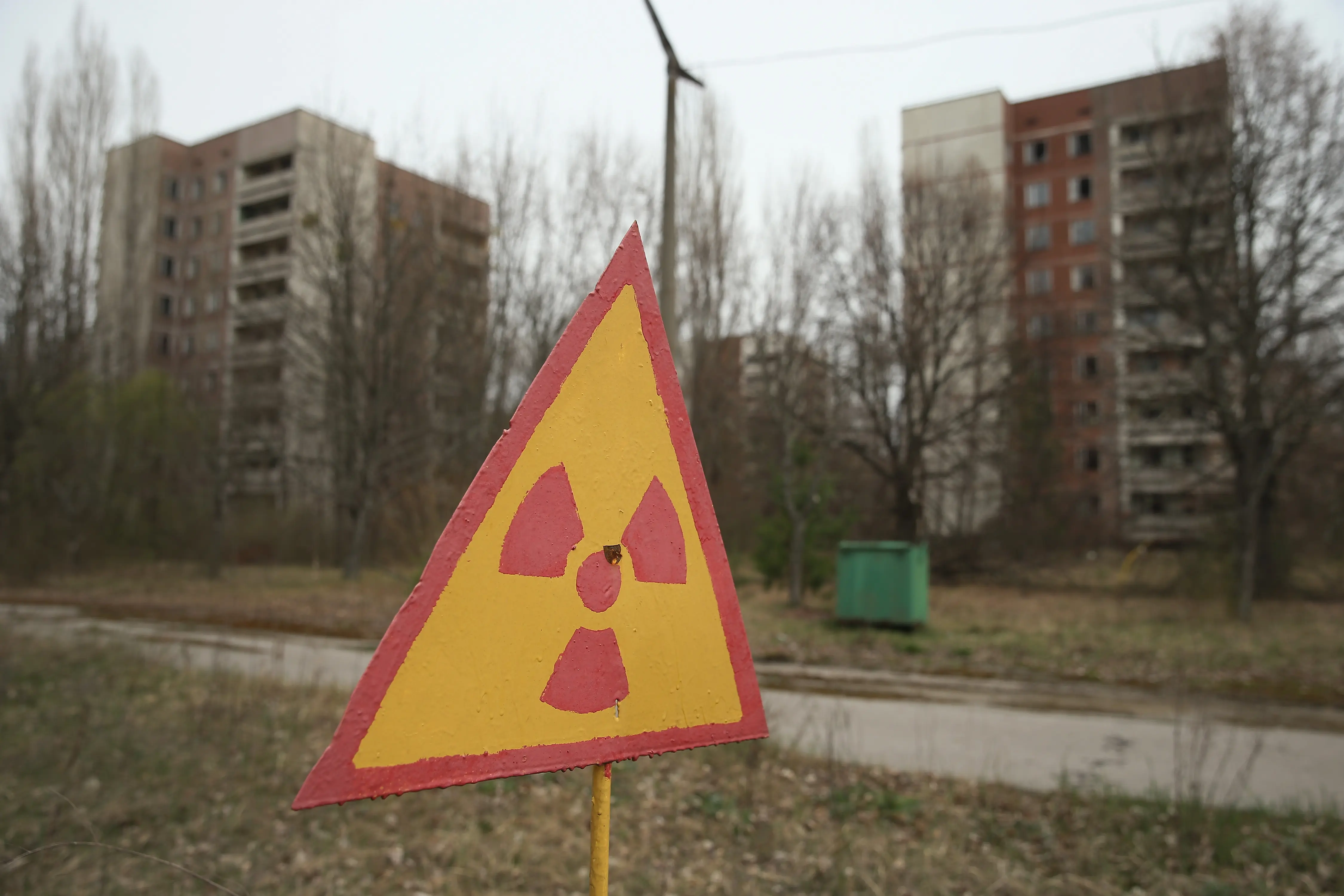Why are Chernobyl dogs turning blue? Mystery explained as abandoned canines' peculiar color baffles caretakers
-
 A sign warns of radiation contamination near former apartment buildings on April 9, 2016 in Pripyat, Ukraine. Pripyat, built in the 1970s as a model Soviet city to house the workers and families of the Chernobyl nuclear power plant, now stands abandoned inside the Chernobyl Exclusion Zone, a restricted zone contaminated by radiation from the 1986 meltdown of reactor number four at the nearby Chernobyl plant in the world's worst civilian nuclear accident that spewed radiaoactive fallout across the globe. Authorities evacuated approximately 43,000 people from Pripyat in the days following the disaster and the city, with its high-rise apartment buildings, hospital, shops, schools, restaurants, cultural center and sports facilities, has remained a ghost-town ever since. The world will soon commemorate the 30th anniversary of the April 26, 1986 Chernobyl disaster. Today tour operators bring tourists in small groups to explore certain portions of the exclusion zone. (Photo by Sean Gallup/Getty Images)
A sign warns of radiation contamination near former apartment buildings on April 9, 2016 in Pripyat, Ukraine. Pripyat, built in the 1970s as a model Soviet city to house the workers and families of the Chernobyl nuclear power plant, now stands abandoned inside the Chernobyl Exclusion Zone, a restricted zone contaminated by radiation from the 1986 meltdown of reactor number four at the nearby Chernobyl plant in the world's worst civilian nuclear accident that spewed radiaoactive fallout across the globe. Authorities evacuated approximately 43,000 people from Pripyat in the days following the disaster and the city, with its high-rise apartment buildings, hospital, shops, schools, restaurants, cultural center and sports facilities, has remained a ghost-town ever since. The world will soon commemorate the 30th anniversary of the April 26, 1986 Chernobyl disaster. Today tour operators bring tourists in small groups to explore certain portions of the exclusion zone. (Photo by Sean Gallup/Getty Images)Chernobyl dogs, the descendants of canine species left over near the nuclear reactors following the evacuations after the disaster in 1986, have been turning blue. Caretakers were perplexed by the phenomenon after discovering that some of the dogs were changing colors.
Dogs of Chernobyl, the organization that cares for the Chernobyl dogs supported by the non-profit Clean Furtures Fund, took to its official Instagram page to share videos and snapshots of the dogs, some of which had turned a strange blue in color.
The organization wrote:
“Blue dogs found in Chernobyl…We are on the ground catching dogs for sterilization and we came across three dogs that were completely blue.”
The organization shared that it was not able to initially determine why the dogs had turned blue. It stated:
“We are not sure exactly what is going. The town people were asking us why the dogs were blue? We do not know the reason and we are attempting to catch them so we can find out what is happening.”
All the same, Dogs of Chernobyl shared that a possible reason for the dogs turning blue could be related to a potential exposure to a chemical.
In its post, the organization added,
“Most likely they’re getting into some sort of chemical.”
In addition to the update, the organization also stated that while it was attempting to round up the affected dogs to examine them more fully, the dogs remained quite active, preventing them from catching the canines.
The Chernobyl dogs have continued to remain a fascination for scientists
On April 26, 1986, one of the nuclear reactors in Ukraine’s Chernobyl Nuclear Power Plant exploded during safety tests being carried out late at night, as per Earth.
The explosion quickly turned into a disaster as radioactive material and smoke spread from the reactor to adjoining areas.
The media outlet also shared that natural life around the plant was impacted, and the nearby forest lost its tress, and birds, aquatic animals and mammals were severely impacted.
However, a recent study conducted on the dogs roaming around the abandoned plant discovered that the radioactive exposure led to genetic changed in the animals, making them more resilient.
According to The Independent, Dr. Norman Kleiman, the lead on the study referred to the canine population operating in the region and said,
“Somehow, two small populations of dogs managed to survive in that highly toxic environment.”
The researchers were led to question what genetic changes the dogs underwent as a result of radioactive exposure in the area.
As per The Independent, Dr. Matthew Breen shared the implications of the study and remarked,
“The overarching question here is: does an environmental disaster of this magnitude have a genetic impact on life in the region?…By teasing out whether or not the genetic changes we detected in these dogs are the canine genome’s response to the exposures the populations have faced, we may be able to understand how the dogs survived in such a hostile environment and what that might mean for any population — animal or human — that experiences similar exposures.”
According to News.com.au, the study examine two groups of dogs, one of which roamed around the abandoned nuclear reactors and the other which lived in Chernobyl city.
The study discovered that the canine population living around the nuclear plant did not intermix with the other population, and had developed 52 genes that researches related to the exposure to contaminants.
TOPICS: Chernobyl dogs, Chernobyl